The following image contains my thoughts on how Twitter might be used within a classroom setting using a preset template.

If you would like to keep up with me on my Twitter journey follow me at @KateRose_McG!
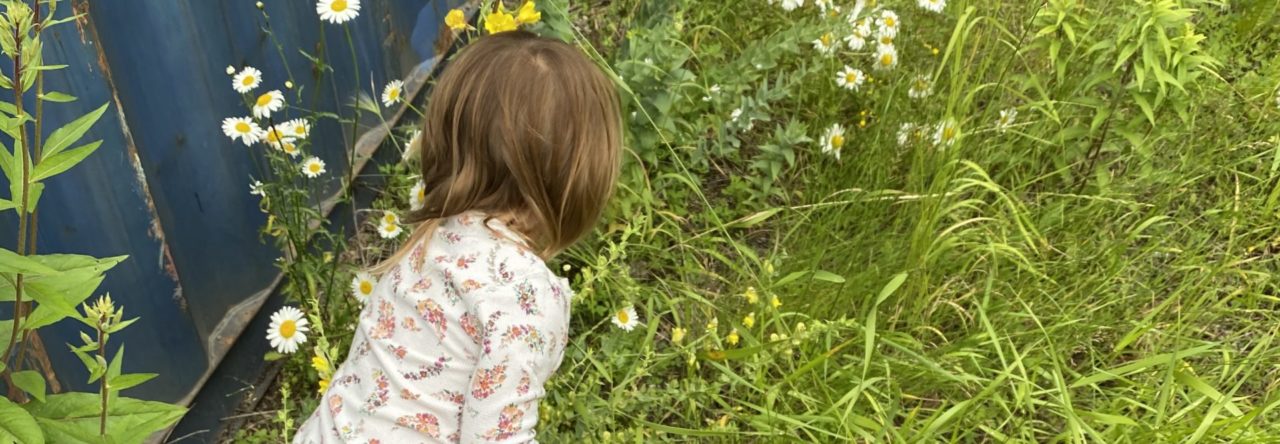
The following image contains my thoughts on how Twitter might be used within a classroom setting using a preset template.

If you would like to keep up with me on my Twitter journey follow me at @KateRose_McG!
Adrienne Gear is dedicated teacher with a love for children’s literature, developing student literacy, and incorporating the love of reading into all subject areas. Gear’s blog provides educators with many different lesson ideas and strong books to use in the classroom. Adrienne Gear’s blog is a must read!
Dedicated to fostering inquiry-based learning within K-12 classrooms, Trevor MacKenzie is an influential educator who has supported many schools around the world. Much of Trevor’s blog guides attention to a new way of learning by giving students learning agency through provocations and inquiry. Trevor MacKenzie’s blog is not one to miss!
Shelley Moore is an educator with a passion for fostering inclusivity in the classroom and supporting diverse learners. Moore’s blog offers many valuable resources for educators including instructional resources, videos, articles, planning templates, and more to support inclusive learning in the classroom. Shelley Moore is an inspiring educator, and her blog is definitely worth checking out!
Course Learning Outcomes:
(Evidence and description of learning will show connections to the course outcomes through bracketed numbers (ex. (5)).
Week 1: Build a PLN/Social Media
Link to Blog Post: Week 1: Build a PLN/Social Media ePortfolio Blog Post
As I began to build a new online presence and explore a new form of networking, I was able to practice and gain further understanding of how beneficial open digital networking can be as I observed and participated in the sharing of ideas and resources amongst the education world (6). (Link to my Twitter profile: Profile)
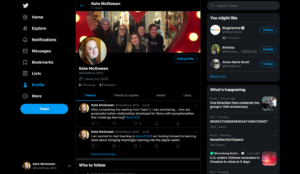
Week 2: Open Learning (Padlet)
Link to Blog Post: Week 2:Open Learning (Padlet) ePortfolio Blog Post
This application allowed me to explore and engage in a new digital networking tool (6). It further promotes the importance of social interaction throughout learning as resources, questions, and advice are openly shared. I found that this application allows for human-centred learning where students are able to pose and answer questions regarding their own interests and foster their academic understanding (1).
Link to Padlet page: https://padlet.com/verenanz/5na
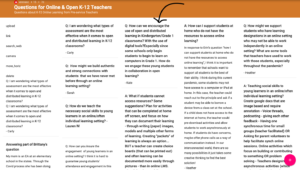
Week 3: Create Activity
Link to Blog Post: Week 3: Create Activity ePortfolio Blog Post
As I made this video, I kept thinking about how animation could be used as a tool to provide multiple means of engagement, representation, and action and expression throughout learning. This would give students equitable access to enjoying learning, explore new materials and demonstrate their learning (4). I was also able to explore new digital technologies that could be used by students or educators to demonstrate learning or deliver information creatively (6).
Link to my Instructional Animation Video:
Universal Design for Learning.mp4
Video Resources:
CAST (2018). Universal Design for Learning Guidelines version 2.2. Retrieved from http://udlguidelines.cast.org

Week 4: Topic 2 Webinar
Link to Blog Post: Week 4: Webinar (Topic 2) – ePortfolio Blog Post
This activity gave us the opportunity to hear more about the perspectives, guidelines and resources available regarding open, online, and remote pedagogy from published professionals. This allowed me to develop a better understanding of these concepts (2) and allowed me to look further into the history and development of online learning as well as the differences between the theories and principles behind online, open, and remote learning (3).
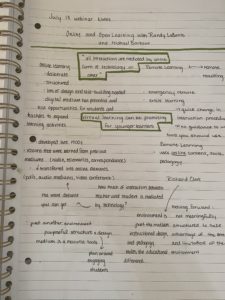
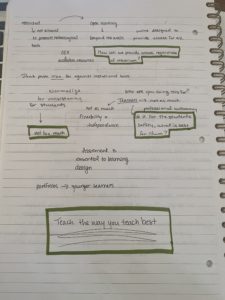
Original Blog Post Link: Topic 2 Blog Post
Take a look at my mind map to see my updating plan! How will I update my Blog Post?
How would you describe the historical and theoretical trends in k-12 online and distributed learning? What did you already know, what do you know now based on the course readings and activities, what do you hope to learn?
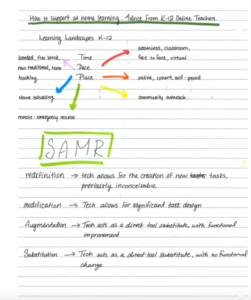
Before this topic, I was unaware of how far back the use of online and distributed learning went especially in Canada. It was interesting to read about the inner workings of distributed and online learning in Canada and how it varies across the country as well as how learning theories and definitions of open, distributed, online, and e-learning have developed and changed over the years.
Learning Theories:
Learning Theories Google Slides Link: Learning Theories
Definitions
Open Education Practices:
Practices which “support the productions, and reuse of high quality open educational resources (OER) through institutional policies, which promote innovative pedagogical models, and respect and empower learners as co-producers on their lifelong learning path (Roberts et Al., p. 528)”.
Open Learning:
8 principles
Blended Learning:
E-Learning/Online Learning
Remote Access / Emergency Learning
“What type of learning setting [do] you think you would be the most successful in: open learning, blended learning, online learning or face to face? What skills do you possess that would make you successful in one setting over another (Heemskerk, 2020)”?
I think I would be most successful learning in a blended learning environment. As blended learning environments aim to offer the best of both worlds for online and traditional learning, this provides students with ample opportunities to explore new tools, resources, interests, and material. It also allows learning to be a mix of synchronous and asynchronous learning which I find works thes best for me. I find that i am able to accomplish more when i am able to discuss and review new concepts in a traditional classroom environment synchronously with an instructor and classmates who can help shine a light on new concepts and later on explore a topic myself asynchronously and spend time diving deeper on my own and demonstrating my knowledge. I am able to work well in groups but I am able to get more done on my own; however I do need help understanding the depth of some concepts. This is where it helps to have blended opportunities. If I had to do just one (online or traditional) I don’t think I would be able to be as successful as I could be. In online, there isn’t as much communication and social interaction to help understand concepts (however, there are growing opportunities for this) and in traditional there is not as much work on your own in your own way time.
History
Canada:
British Columbia:
Growth and Development of Online and Open Learning since the onset of COVID -19:
Q: How has online learning worked for younger students? How effective has it been? Positive effects? Negative Effects?
Answers from Current Teachers: Teacher Responses
Moving On:
Further Resources:
References:
Barbour, M & Labonte, R. (2018) An Overview of eLearning Organizations and Practices in Canada. In R. Ferdig & K. Kennedy (Eds.), Handbook of research on K-12 online and blended learning (pp. 600-616). Pittsburgh, PA: Carnegie Mellon University ETC Press.
Barbour, M & Labonte, R. (July 14, 2020) Open and Online Learning in a K-12 Context. Topic 2 Webinar Retrieved from: https://edtechuvic.ca/vroberts/2020/07/14/topic-2-online-open-learning-webinar-with-dr-randy-labonte-dr -michael-barbour/
Bates, T.(2014). Learning Theories and Online Learning. [Blog post]. Retrieved from https://www.tonybates.ca/2014/07/29/learning-theories -and-online-learning/.
Doyle, Nadine (July 22, 2020). Interview.
Garrett Dickers, A. (2018) Social Interaction in K-12 Online Learning. In R. Ferdig & K. Kennedy (Eds.), Handbook of research on K-12 online and blended learning (pp. 509-522 ). Pittsburgh, PA: Carnegie Mellon University ETC Press.
Heemskerk, C. (July 14, 2020). Topic 2 Blog Reply. Carly’s Corner. Retrieved from:https://carlyheemskerk.opened.ca/category/distributed-and-open-learning/
Helfrich, Kristen (July 22, 2020). Interview
Roberts, V. , Blomgren, C. Ishmael, K. & Graham, L. (2018) Open Educational Practices in K-12 Online and Blended Learning Environments. In R. Ferdig & K. Kennedy (Eds.), Handbook of research on K-12 online and blended learning (pp. 527–544). Pittsburgh, PA: Carnegie Mellon University ETC Press.
Throughout this course there were only two webinars that occurred and unfortunately I wasn’t able to make either of them in person. However, I decided that for my last optional activity I was going to attend the webinar via the recording that was provided and follow along with the google docs notes that were created during the realtime meeting. I really enjoyed this webinar as the quests (Randy LaBonte and Michael Barbour), Dr. Verena Roberts, and the students who were n attendance provided insights and varying perspectives to the topics discussed. It was interesting to here the different views regarding the differences and similarities between online, open, and remote learning as some were in agreement and some conflicted.
My Notes:


Some of my main take aways:
I connected this activity to the course outcomes:
How can teachers find, build & share resources and content to support learners in K-12 online & open digital contexts? What did I already know, what do I know now based on the course readings and activities, what do I hope to learn?
What I Know
Before this topic I was aware of Open Educational Resources but was only slightly aware of the detail of what they entailed and the guidelines behind what could be considered an open educational resource and what doesn’t.
What I learned
Being able to find, share, and create resources and learning content to support K-12 online and digital contacts is essential to providing students with an enriched education that provides them with accurate material, new perspectives, new experiences, and opportunities. There are many open resources available for educators and students to explore new material. Many can be found online through programs that allow educators to share and receive free advice and resources in order to freshen up learning plans or create more personalized, open, or exploratory learning opportunities. These open educational resources (OER) can be determined by the license that their are created and distributed under. This would included an open license, a Creative Commons license, or anything within the public domain. This licenses serve as a copyright license which allows educators to engage in any of the 5Rs:
Retain – The right to make own, and control copies of the content.
Reuse – the right to use the content in a wide range of ways.
Revise – the right to adapt, adjust, modify, or alter the content itself.
Remix – the right to combine the original or revised content with other material to create something new.
Redistribute – the right to share copies of the original content, your revisions, or your remixes with others (Wiley and Hilton, 2018, p.134-35).
The use of these open educational resources (OER) are used to engage students and educators in OER enabled pedagogy which is “defined as the set of teaching and learning practices that are only possible or practical in the context of the 5R permissions that are characteristics of OER (Wiley and Hilton, 2018, p.133)”.
OER are also important to implement and make use of within the K-12 eduction system. Most often many resources such as textbooks are used; however they are bought in abundance and can soon become out of date as school don’t necessarily have the funds to continuously repurchase and update their physical resources as the resources consistently update and come out with new editions (Kimmons, 2015). By educating teachers in how to find accurate and openly licensed materials, they can be better equipped to provide and share new and accurate resources for their students. Some of the resources that are found may even provide real-life experience or connections that can help make the learning journey more relatable and meaningful to students. OER is filled with large amounts of potential to support the benefits of learning in K-12 online and open learning environments.
What I want to Know
I am looking forward to learning more about finding OER and how to best distributed and use them within a classroom especially at the primary level.
References:
Kimmons, R. (2015). OER quality and adaptation in K-12: Comparing teacher evaluations of copyright-restricted, open, and open/adapted textbooks. The International Review of Research in Open and Distance Learning. 16(5), 39–57. https://doi.org/10.19173/irrodl.v16i5.2341
Shellynvc. (August 22, 2013). OER (Open Educational Resources) Introduction II. [Youtube] Retrieved from: https://www.youtube.com/watch?v=Yfl1B6Qmp5g
Wiley, D. & Hilton, J. (2018). Defining OER-enabled Pedagogy. International Review of Research in Open and Distance Learning, 19( 4). http://dx.doi.org/10.19173/irrodl.v19
Please take a look at our mind map chart of our Persona!
We have created a pitch that highlights the steps we would take to create a safe learning environment, where Bob can be successful. We decided that Bob would be best suited in a blended learning environment where he is able to learn asynchronously and synchronously, online and face to face. This would allow Bob to learn at his own pace and with choices that would personalize and ultimately optimize his learning experience. Roberts et al. share that blended environments have a “higher level of effectiveness than fully online or fully face-to-face environments. In addition, they found that when online courses are either teacher directed or contain a great deal of peer-to-peer support, the effectiveness of the approach is greater than courses that use a purely independent study (2018, p.539)”. To provide a better idea of what this would look like, here is an example lesson that we would share with Bob in a blended learning setting (Example Lesson). This lesson plan was created based on the Universal Design for Learning (UDL) Guidelines and it has been aimed to provide multiple means of engagement, representation and expression. We know that UDL “supports, and challenges, and maintains high achievement expectations for all students, including students with disabilities and students who are limited english proficient. (Basham et al., 2018, pp. 477 – 78); blended learning is a great opportunity to put UDL into practice because it is so flexible.
In their article, Basham et al. describe a series of studies which aim to study the effects of utilizing UDL in the classroom. One Study stood out to us in particular as it occurred at the middle school level and looked at increasing engagement for students with learning disabilities. This study UDL in the Middle School Science Classroom: Can Video Games and Alternative Text Heighten Engagement and Learning for Students With Learning Disabilities, followed approximately 60 middle school students with learning disabilities as they rotated their use of traditional learning materials with alternative games and texts (based off of UDL) between science units. This allowed students to engage in multiple means of expression and representation and did report an increased level in student engagement (Basham et al., 2018). This study replicates the ideas that we had to support our student, Bob. We aim to encourage his learning and the achievement of his goals through positive engagement and learning activities. We believe that a learning program where he is able to explore topics through familiar and enjoyable means of expression and representation will ultimately encourage understanding, motivation, and learning.
In response to Selwyn’s article “Online Learning: Rethinking teachers’ ‘digital competence’ in light of COVID-19” (2020) we sought to provide our student with as much support as possible throughout his learning. As Selwyn describes the importance of providing support academically and emotionally for students during these times, we would be sure to provide Bob with maximum support such as web chats or video calls to check in and see where and if help is needed as well to help him keep on track. This can be seen in the Handy Hints! section of our example lesson and would be expanded upon if this learning plan were to carry over during the COVID-19 period.
Universal Design for Learning Considerations
Multiple Means of Engagement – Checkpoint 7.1
“Optimize individual choice and autonomy”
Roberts et al. (2018) confirm the importance of engaging their students by stating that “educators need to promote students’ engagement in their own learning and the various environments in which it occurs”(p. 540). By providing Bob with various options to engage in the project, he is more likely to get engaged and finish with a sense of accomplishment. We provided activities that span through difficulty level and this will provide the option of challenging himself in a safe environment because if he runs into a problem he knows he can choose one of the easier options.
Multiple Means of Representation – Checkpoint 2.5
“Illustrate through multiple media”
Bob struggles with reading due to dyslexia so it is crucial we provide him with different options as opposed to just words. In our example lesson we used words, pictures and a voice over to help Bob follow along in whatever way he chooses.
Multiple Means of Expression and Action – Checkpoint 5.1
“Use multiple media for communication”
We provided Bob with options to supplement his prior readings in a way that interests him. For example, we allowed Bob the chance to communicate his new knowledge using videos, drawings, pictures, words or a blend of all these.
We understand that Bob and his family are dealing with digital equity issues at home and we kept this in mind when creating this lesson plan. Bob has access to a device and to wifi, however, due to his large family he does not have access throughout the whole day. This requires us, as educators, to plan ahead and be ready to answer Bob’s questions in the short time we have together. Additionally, we provided work that can be done at a pace that works for the students and that can be done without using digital resources. Although this specific lesson plan is asynchronous, it provides opportunities for Bob to interact with his classmates and demonstrate his work if he chooses to. As we shared in our mind map, Bob is extremely sociable and therefore, relationships in an online learning environment are crucial in order for Bob to be successful and happy.
Expanding upon providing multiple means for engagement, we are giving Bob autonomy by allowing him to work through this project at his own pace; however, the checklist will provide structure and support to ensure he does not fall behind or get confused. We believe that our pitch will allow Bob to feel like he is in control of his own learning and provide him with a sense of responsibility. Bob would be much more successful in this new blended learning environment because it offers him support when he needs it, however, it also provides him with autonomy to work at his own pace. Support in a blended learning environment can come from many different people; it is not only just the teacher responsible for sharing the knowledge. Online learning opens many new doors for students because it is “based on the respect of individual differences; it emphasizes the individual learner’s growth within today’s world; it changes the role of the teacher to an indirect influence thus contrasting to an older model that emphasizes the direct role of the teacher…”(Roberts et Al., 2018, p. 529). Blended classrooms provide more opportunities for students to learn from their peers and collaborate with each other in new ways. Ultimately, this provides the teacher with more time to help students that are struggling in the same ways that Bob is!
References:
Basham, J.D., Blackorby, J., Stahl, S. & Zhang, L. (2018) Universal Design for Learning Because Students are (the) Variable. In R. Ferdig & K. Kennedy (Eds.), Handbook of research on K-12 online and blended learning (pp. 477-507). Pittsburgh, PA: Carnegie Mellon University ETC Press.
CAST (2018). Optimize Individual Choice and Autonomy. Universal Design for Learning Guidelines version 2.2. Retrieved from http://udlguidelines.cast.org/engagement/recruiting-interest/choice-autonomy
CAST (2018). Use Multiple Media for Communication. Universal Design for Learning Guidelines version 2.2. Retrieved from http://udlguidelines.cast.org/action-expression/expression-communication/use-multimedia
CAST (2018). Illustrate through Multiple Media. Universal Design for Learning Guidelines version 2.2. Retrieved from http://udlguidelines.cast.org/representation/language-symbols/illustrate-multimedia
Common Sense Video. (n.d.) We the Digital Citizens. Common Sense Education. Retrieved from: https://www.commonsense.org/education/videos/we-the-digital-citizens
Flipgrid [Web page]. (n.d). Retrieved from: https://help.flipgrid.com/hc/en-us/articles/360007460474-Getting-Started-Educators
Giarlia, A. (June 17, 2020). The Benefits of Blended Learning. TeachThought. Retrieved from: https://www.teachthought.com/technology/the-benefits-of-blended-learning/
Kahoot [Web page]. (n.d). Retrieved from: https://kahoot.com/schools/how-it-works/
Roberts, V. , Blomgren, C. Ishmael, K. & Graham, L. (2018) Open Educational Practices in K-12 Online and Blended Learning Environments. In R. Ferdig & K Kennedy (Eds.), Handbook of research on K-12 online and blended learning (pp. 527–544). Pittsburgh, PA: Carnegie Mellon University ETC Press.
Selwyn. N. (2020). Online learning: Rethinking teachers’ ‘digital competence’ in light of COVID-19. [Weblog]. Retrieved from: https://lens.monash.edu/@education/2020/04/30/1380 217/online-learning-rethinking-teachers-digital-compet ence-in-light-of-covid-19
Texthelp. (2018). Read&Write for Google Chrome – A how to guide for students [Video file] Retrieved from: https://www.youtube.com/watch?v=YJ5N1BQc0bc
Woodfine, B.P., Baptista Nunes, M., Wright, D.J. (April 2008). Text-based synchronous e-learning and dyslexia: Not necessarily the perfect match! Computers and Education Vol.50, Issue 3. P. 703-717. Retrieved from: https://www.sciencedirect.com/science/article/abs/pii/S0360131506001217
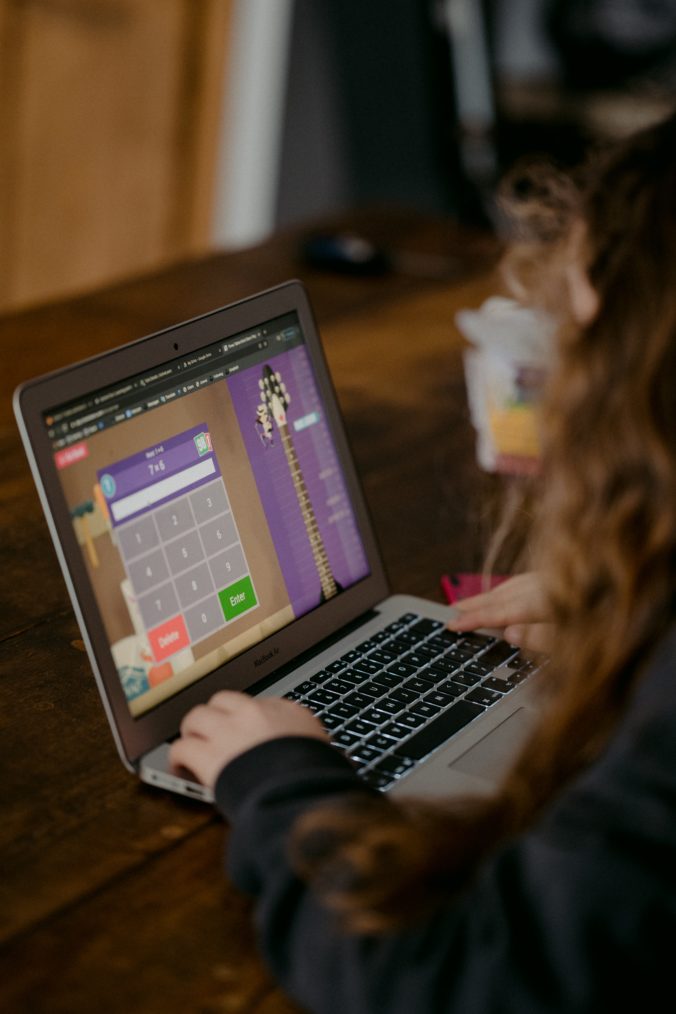
How can you ensure equitable access to authentic, meaningful & relevant learning environments for all learners in K-12 open and distributed learning contexts? What did you already know, what do you know now based on the course readings and activities, what do you hope to learn?
Ensuring that there is equitable access to authentic, meaningful, and relevant learning environments for all learners inside and beyond the classroom is vital for providing students with an optimal learning experience. By making sure that students are each able to access all materials, engage in all the same experiences, and have the same opportunities, students will be able to have a more enriched learning experience and equal opportunities for growth and development. As stated by the Basham et al. (2018) classrooms are continually increasing in regards to student diversity. It important that each student is provided with the means to ensure their success and this can be done by providing each student with equitable access, materials, support, and autonomous learning opportunities based upon their individual learning needs. This can be done by considering the Universal Design for Learning Guidelines to design learning activities.
Universal Design for Learning: “a scientifically valid conceptual framework for guiding educational practice that provides flexibility in the ways information is presented, in the ways students respond or demonstrate knowledge and skills, and in the ways students are engaged (Basham et al. 2020, p.480)” . The guidelines for the UDL are based on three main principles which are meant to addresses and provide support for the large variability of students within today’s classroom. These principles are:
Multiple means of engagement: provide options for
Multiple means of representation: provide options for
Multiple means of action and expression: provide options for
For more check out: http://udlguidelines.cast.org
To help ensure equity in learning environments we can also consider the design principles suggested by Kral and Swab (2012).
(1) A space young people control
(2) A space for hanging out and ‘mucking around’
(3) A space where learners learn
(4) A space to grow into new roles and responsibilities
(5) A space to practice oral and written language
(6) A space to express self and cultural identity through multimodal forms
(7) A space to develop and engage in enterprise
(8) A space to engage with the world
By providing students opportunities to learn in environments where they have control, take new responsibilities, and engage in real-life experiences, students my develop a new found respect and motivation for learning as they become invested and interested in what they are learning as they explore ideas beyond traditional classroom work.
I am looking forward to learning more about various strategies for implementing the UDL concept in online learning.
References:
CAST (2018). Universal Design for Learning Guidelines version 2.2. Retrieved from http://udlguidelines.cast.org
Kral, I. & Schwab, R.G. (2012). Chapter 4: Design Principles for Indigenous Learning Spaces. Safe Learning Spaces. Youth, Literacy and New Media in Remote Indigenous Australia. ANU Press .http://doi.org/10.22459/LS.08.2012 Retrieved from: https://press.anu.edu.au/publications/learning-spaces %EF%BB%BF
Basham, J.D., Blackorby, J., Stahl, S. & Zhang, L. (2018) Universal Design for Learning Because Students are (the) Variable. In R. Ferdig & K. Kennedy (Eds.), Handbook of research on K-12 online and blended learning (pp. 477-507). Pittsburgh, PA: Carnegie Mellon University ETC Press.
For this week’s optional activity I chose to engage in a create activity. The instructions for any create activity ask us to create a 5 minute Video/ Podcast or Digital Artifact which describes: “How you would “teach/ design, create or share” something for another teacher based on the weekly course topics. I chose to try something completely out of my comfort zone and create a basic animation video. I made my video about Universal Design for Learning (Topic 3) using an application called Animaker. This application allowed me to experiment with transitions, creativity and flow of information and furthermore allowed me to try something new. I still have a lot to learn about making informative animation such as transitional flow and setting things into correct time frames. This activity was very fun and the application is something I will look into in the future. I linked this activity to the course outcomes:
Check out my video!
Link to Animaker.
Information retrieved from:
CAST (2018). Universal Design for Learning Guidelines version 2.2. Retrieved from http://udlguidelines.cast.org
This week I chose to participate in the open learning activity which introduced us to Padlet.
To participate we were required to: Ask and answer questions about K-12 open & online learning in a digital open learning commons using Padlet.
Padlet is a online resource application where educators and students can post questions and answer each other’s questions either as themselves, someone else, or anonymously. Users can feel free to pose questions and ask for advice and are able to receive advice and answers from multiple people which beneficially provides a multitude of perspectives to explore. Users are also able to post attachments, links, and other files they would like to share.
Teachers can build personalized post-it boards where classmates can share and respond to ideas. studies can reach this board through a personal link provided by the educator. This application can be used as a way to brainstorm, complete group work, gather students’ evidence of learning, etc.
I really enjoy this application. It seems to really relate to the importance of social interaction in open learning promoted by topics one and two. With this application it promotes the idea of teachers, students, and the public learning together as they are able to collaborate and share new materials and ideas.
I have connected this activity to the course outcome:
Develop an awareness of the potential of human-centered learning in online and open learning contexts and Practice digital, networked, and open literacies in support of learning about distributed and open learning.
This activity connects to these outcomes as this application allows for human centre learning as students are able to pose and answer questions regarding things that they are interested in and based on what they have experienced. It also allowed me to explore a new digital networking tool which was really fun!
This is the question I posted on Padlet…
Q: How can we encourage the use of open and distributed learning in Kindergarten/Grade 1 classrooms? With the use of digital tools?Especially since some schools only begin students to begin to learn on computers in Grade 1. How do we engage these young students in collaboration in open learning?
Here are some of the answers I received…
A: Teaching social skills to young learners in an online/often individual learning setting? Create google docs that are image based and require annotation – Voice threads, podcasting – giving each other feedback – Having one synchronous time for small groups (teacher facilitated) OR Asking for parent volunteers to help facilitate synch online sessions. Online activities which focus on building or contributing to something OR problem solving – Teachers designing fro asynchronous activities (which can be explained through text, video or podcast) that encourage students to complete tasks together (scavenger hunts). This post describes some interactive practices: https://www.bookwidgets.com/blog/2018/06/20-interactive-teaching-activities-for-in-the-interactive-classroom This post expands on these “Making thinking visible” strategies: https://arpdcresources.ca/consortia/thinking-strategies/ (retrieved from https://padlet.com/verenanz/5na90f0mkywgdcmh)
Carly I really enjoyed reading your blog post! I really enjoyed how it was organized and you included your own experiences and ideas while reviewing each reading from this topic.
I enjoyed your comment about design principle #5. I to never recognized the potential of online learning in regards to oral language learning and I am interested to see how educators support that using a digital forum. I also agree with your statement that “allowing students the opportunity to make their own decisions regarding their own learning is crucial because it requires them to take responsibility of their own learning and learn about what works best for them personally (Heemskerk, 2020)”. It is so important that students are able to engage in learning autonomy and have opportunities that motivate them to engage in more learning experiences.
I am interested to know how you think we can implement more of Kral’s design principles into our everyday classrooms.
Also how do you think we can use digital platforms to encourage the development of oral second language learning.
P.S. you forgot the citation for Selwyn’s article 🙂
Powered by WordPress & Theme by Anders Norén